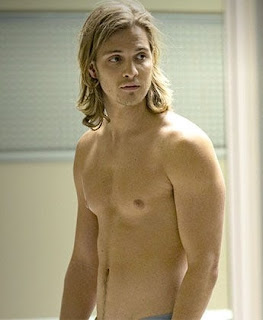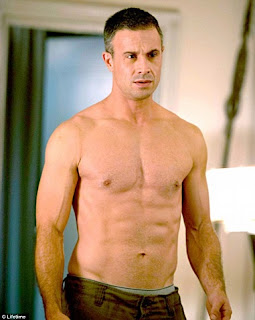Movie night this week was The Magnificent Seven (2016), a remake of the 1960 movie, which was in turn a remake of The Seven Samurai (1954), neither of which I have seen. Apparently I'm not missing much. It was 133 minutes of killing people.
In the Old West in 1879, snarling, sneering, moustache-twirling cartoon villain Bogue and his absurdly huge army of miscreants storm into the idyllic frontier town of Rose Creek, demanding that the townsfolk sell their land for a pittance and agree to be worked to death in his mines. Anyone who refuses will be killed. To show that he is serious, he kills about 20 of them on the spot, and burns down the church.
Cut to another town, where Emma, who lost her husband, and her friend Teddy (Luke Grimes, top photo) have settled. When bounty hunter Sam Chisholm (Denzel Washington) rides in and kills everyone in the town tavern, they ask if he would be interested in killing Bogue and liberating the town. He hates Bogue, so he agrees. He gathers a diverse group of marksmen to help:
1.-3. Teddy, Chisholm, and Emma
4. Mischievous scamp Josh Faraday (Chris Pratt)
5-6. Former Confederate soldier Goodnight Robichaux (Ethan Hawke) and his boyfriend, an Asian knife-thrower named Billy Rocks (Byung-hun Lee, left)
7. Vasquez (Manuel Garcia-Rulfo), a Mexican outlaw. One of his colleagues doesn't like Mexicans.
8. Jack Horne, a retired Indian-killer who is not all there.
9. Red Harvest (Martin Sensmeier, below), a Comanche who speaks no English, and uses a bow and arrow instead of a gun. He bonds with Jack Horne, for some reason.
Chisholm is black in 1879, but his race is irrelevant. It is surprising, therefore, that "learning to overcome racial prejudice" is part of the character development of at least four of the Magnificent Nine.
And while I'm on the topic of plot inconsistencies, where, exactly, is this town? Chisholm works out of Wichita, Kansas, but the Comanche territory was west Texas and eastern New Mexico, but the town is three days by horseback from Sacramento, California. I guess the writers didn't bother to look at a map. Exteriors were filmed in Louisiana, Colorado, and New Mexico.
After the colorful "gathering the gang" scenes, the Magnificent Nine roll into Rose Creek and kill about 300 of Bogue's men, plus the townsfolk who joined his side. How are they better than Bogue?
Bogue owns hundreds of towns throughout the Wild West, so he could just let this one go -- but no, he's snarling and unstable, so he decides to ride out himself with his absurdly huge army and kill everyone.
It takes three days to get to Sacramento, and three days to get back, so the Magnificent Nine have just under a week to whip the surviving townsfolk into an army -- a problem because most of them have never touched a gun before (in the Wild West?). They also rig the town with booby traps and lots of dynomite.
The Bogue army arrives, and everyone kills everyone. Body after body, death after death, for about twenty minutes. All of Bogue's army, most of the surviving townsfolk, and most of the Magnificent Nine die. I'm wondering why you want to liberate a town full of corpses. Teddy, Emma, Red Harvest, and Chisholm survive, and Emma voice-overs that the Seven were "magnificent."
Beefcake: No. A lot of close-ups of unshaven, sweaty men staring at each other just before they shoot.
Other Sights: Rose Creek is a stereotypic Hollywood one-street town, which nevertheless manages to support a hotel and a restaurant. How many visitors other than assassins does it get?
Gay Characters: #5-6. Apparently the writers intended for them to be gay, but the studio insisted on just a subtext, to allow for deniability: "What? No, you're reading too much into it. They're just friends. Gay people didn't exist in the Old West."
Heterosexism: Surprisingly, there are only a few scattered references to heterosexual desire, and no one falls in love. I was very surprised that Emma didn't hook up with Teddy or Chisholm.
Body Count: Endless.
My Grade: I have a new rule. No movies with more than 58 deaths. How did anyone in the Old West survive?













